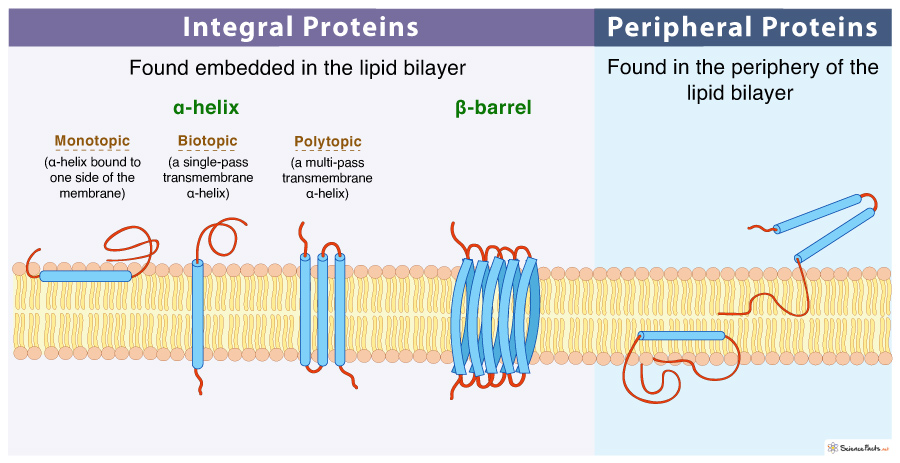Peripheral Membrane Proteins
Peripheral proteins are one of two membrane proteins found in living organisms, the other being integral proteins. As the name suggests, peripheral membrane proteins are located in the periphery of the lipid bilayer of cell membranes, attaching to the integral membrane proteins or penetrating the lipid bilayer. Thus they are also called extrinsic membrane proteins.
The specific amino acid sequence in peripheral proteins allows them to interact with the phosphate head of the lipids or with the integral membrane proteins. They never enter the hydrophobic space of the bilayer. Peripheral membrane proteins are involved in many signaling pathways, allow the movement of molecules in and out of the cell, and helps in cell interactions.
Electron transport chain proteins, such as cytochrome c, cupredoxins, high potential iron protein, adrenodoxin reductase, and some flavoproteins, are some examples of peripheral proteins.
Structure of Peripheral Membrane Proteins
Peripheral membrane proteins vary in shape and size. Due to the amphipathic nature of phosphoglycerides, peripheral proteins do not have a hydrophobic region of amino acids. However, they have lots of hydrophilic amino acids exposed on their surface.
Functions of Peripheral Membrane Proteins
Although they do not penetrate the cell membrane, they play a vital role in the proper functioning of the cell.
1. Transporting Molecules
They allow the entry and exit of many molecules within and outside the cell. Electron transport chain proteins, such as cytochrome c, cupredoxins, high potential iron protein, adrenodoxin reductase, and flavoproteins, are all peripheral proteins transferring electrons from one protein to another. Without cytochrome c, the proteins responsible for generating energy would not obtain the electrons necessary for generating energy in mitochondria.
Without cytochrome c, damaged cells will not undergo cell death, causing them to become cancerous. Usually, a damaged cell produces cytochrome c from the membranes of the mitochondria, activating a cascade protein series and causing apoptosis. Thus cytochrome c being a peripheral membrane, acts as a good wingman.
Some peripheral proteins transport small hydrophobic molecules such as phosphatidylinositol, tocopherol, gangliosides, glycolipids, sterol derivatives, retinol, fatty acids, water, macromolecules, red blood cells, phospholipids, nucleotides.
2. Communication
Besides transporting, peripheral membrane proteins help communicate within a cell or adjacent bacterial cells in a colony. On stimulating the peripheral proteins, they activate the integral proteins, which then transfer the message to another peripheral protein, generating a target response.
Similarly, peripheral proteins create chain reactions, stimulating a response from the DNA or other cell organelles. It helps the cell to grow, react to danger, or release toxins that help to communicate with nearby cells.
Some polypeptide hormones, antimicrobial peptides, and neurotoxins accumulate at the membrane and interact with the target receptors, which are peripheral proteins.
3. Anchoring Membranes
Peripheral proteins anchor the cell and intracellular membranes (mitochondrial membranes) by binding to the exterior hydrophilic lipid molecules and the integral membrane proteins. The amino acid sequence of these proteins is such that they hang out on either side of the membrane. They attach loosely to integral membrane proteins or phosphoglyceride lipid molecules through hydrogen bonds.
4. Providing Support
They form the point of attachment of the cytoskeleton and the extracellular matrix to the cell membrane. Thus, indirectly peripheral proteins help cells to maintain cell shape and size. Since the cytoskeleton also moves the products of metabolism throughout the cell, peripheral proteins control such functions. For example, when a packaged protein from Golgi reaches the cell membrane, specific peripheral proteins recognize the package and start expelling it.
5. Acting as Enzymes
Some peripheral proteins participate in the metabolism of different membrane components, such as lipids (phospholipases), cell wall oligosaccharides (glycosyltransferase), or proteins (signal peptidase).
Some peripheral proteins participating in other chemical reactions are phospholipase C, lipoxygenases, sphingomyelinase C, alpha toxins, and glycolate oxidase.
Integral vs. Peripheral Proteins
Some key differences between the two main types of membrane proteins are explained below.
| Basis | Integral Proteins | Peripheral Proteins |
|---|---|---|
| 1. Other Name | Intrinsic protein | Extrinsic protein |
| 2. Location | Embedded throughout the membrane | Embedded on the inner and the outer surface of the phospholipid bilayer |
| 3. Functions | Transport substances in and out of the cellServe as receptors, linkers, signal transducers, cell adhesion molecules, and anchorage | Serve as receptors, surface antigens, and enzymesHelp in communication within and outside the cell |
| 4. Hydrophobic and Hydrophilic Domain | Contain both hydrophobic and hydrophilic domain | Contain only hydrophilic domain |
| 5. Interaction with the Lipid Bilayer | Interact highly with the hydrophobic part of the lipid bilayerBinds to lipid bilayer through hydrophobic, electrostatic, or non-covalent interactions | Interact less with the hydrophobic part of the lipid bilayerOn the inner surface, it is held by the cytoskeleton |
| 6. Membrane Constituent | Consists of almost 70% of all membrane proteins | Consists of almost 30% of all membrane proteins |
| 7. Examples | Glycophorin, integrin, cadherin, selectins, rhodopsin, and G-protein coupled receptors | Cytochrome c, cupredoxins, and some flavoproteins |
| 8. Purification | Difficult | Easy |
| 9. Removal | Using detergents | Using a dilute salt solution |
-
References
Article was last reviewed on Friday, November 18, 2022




